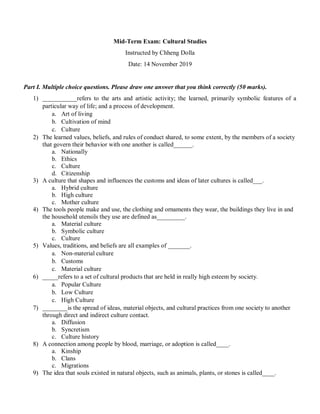
Khmer Empire Comprehsive Reading
- 1. Mid-Term Exam: Cultural Studies Instructed by Chheng Dolla Date: 14 November 2019 Part I. Multiple choice questions. Please draw one answer that you think correctly (50 marks). 1) ___________refers to the arts and artistic activity; the learned, primarily symbolic features of a particular way of life; and a process of development. a. Art of living b. Cultivation of mind c. Culture 2) The learned values, beliefs, and rules of conduct shared, to some extent, by the members of a society that govern their behavior with one another is called______. a. Nationally b. Ethics c. Culture d. Citizenship 3) A culture that shapes and influences the customs and ideas of later cultures is called___. a. Hybrid culture b. High culture c. Mother culture 4) The tools people make and use, the clothing and ornaments they wear, the buildings they live in and the household utensils they use are defined as_________. a. Material culture b. Symbolic culture c. Culture 5) Values, traditions, and beliefs are all examples of _______. a. Non-material culture b. Customs c. Material culture 6) _____refers to a set of cultural products that are held in really high esteem by society. a. Popular Culture b. Low Culture c. High Culture 7) ________is the spread of ideas, material objects, and cultural practices from one society to another through direct and indirect culture contact. a. Diffusion b. Syncretism c. Culture history 8) A connection among people by blood, marriage, or adoption is called____. a. Kinship b. Clans c. Migrations 9) The idea that souls existed in natural objects, such as animals, plants, or stones is called____.
- 2. a. Animism b. Division c. Myth 10) The shortage of labor and higher wages weakened feudalism because workers began to____in search of higher wages. a. Proletariat b. Migrate c. Bourgeoisie Part II. Comprehensive Reading: The Khmer Empire (50 marks) 1. Another peninsula—the Indochinese Peninsula—extends to the south of China. It is the location of the Khmer Empire, the most powerful and longest-lasting kingdom on the mainland of Southeast Asia. It was centered in what is today Cambodia. The culture of Khmer was influenced by its northern neighbor, China. But its western neighbor, India, had a much stronger impact. From India, the Khmers took ideas about rule by a god-king, a writing system, and forms of religion—Buddhism and Hinduism. Indeed, according to legend the Khmer rulers were descended from a marriage arranged by the Hindu deity Shiva. 2. Early History Around A.D. 100, people in what is now the southern part of Cambodia set up the kingdom of Funan. The Funanese were a seafaring people who had trade relations with China and other lands. However, they were influenced by many Indian customs, including the Hindu religion. By the 500s, Funan had gone into decline. People from the north, known as Khmers, moved into the area and set up several small kingdoms. 3. The economies of these kingdoms were based on trade and farming. However, they prospered mainly because of their successful cultivation of rice, which they learned from the Chinese. Peasant farmers built excellent irrigation systems to help them grow the crop. They also developed better seeds that may have allowed them to grow as many as three crops a year. 4. Angkor Era by the 800s, the Khmer kingdoms had combined into a great empire. At that time, the Khmer ruler began to build a new capital at Angkor. Several temples were constructed there. The most famous formed a complex known as Angkor Wat, built in the 1100s. The complex was built as a symbolic mountain dedicated to the Hindu deity Vishnu. The builders of the temple covered the walls with carvings of the highest quality. Some illustrate the deeds of Vishnu. Others show scenes from Khmer history. The Khmer Empire reached its peak in the 1200s, when it controlled much of the Indochinese Peninsula. However, it started to decline in the 1300s. The huge building programs undertaken by Khmer rulers drained resources. Also, the empire came under attack from nearby kingdoms. In 1431, Angkor fell to the Thais (tyz), a people from what is now Thailand. Multiple choice questions Vocabulary Questions 1. What does "deity" mean? A. a symbol of a family, organization B. a god or goddess C. special ancient decorations 2. What does " seafaring people" mean? A. Following a life at sea B. A cultivation of rice and fishing along the river
- 3. C. Aggressors attached on mainland 3. What does "Customs" mean? A. a border-place where Funan trades with Indian and Chinese B. tradition and beliefs C. a smooth, strong cloth used to make high-quality fabrics by Indian 4. What does "Cultivation" mean? A. traditional way of agriculture B. production of food by preparing the land to grow C. Improving of rice production through new innovation 5. What does " Empire " mean? A. High culture B. A large and powerful state C. Diffusion of Funan culture Wh Questions 6. Where did “god-king” originate? A. Funan B. China C. India 7. When did Angkor Era become popular? A. the period from A.D 100-800 B. the period from A.D 800-1200 C. the period from A.D 1300-1431 8. Why did Khmer Empire become less popular? A. State influenced by India, and this made people adopt Indian style. B. The cost of huge building programs undertaken by rulers drained resources C. Both answers True or False? 9. Based on the information in this lesson, is the following statement true or false? " From India, the Khmers took ideas about rule by a god-king, a writing system, and forms of religion." A. True B. false 10. Based on the information in this lesson, is the following statement true or false? " According to legend the Khmer rulers were descended from a marriage arranged by the Hindu deity Confucianism." A. True B. False “Good Luck!”
